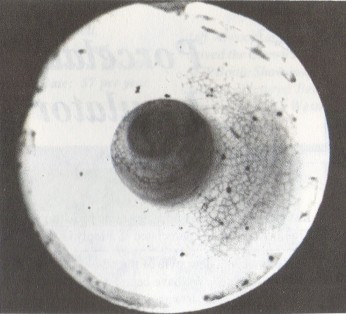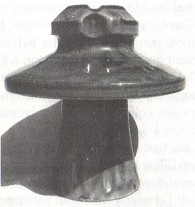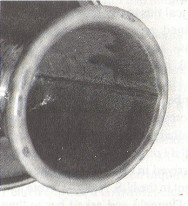It is rare indeed when a new style of threadless porcelain insulator is
reported. We have been late in getting this report in "PIN", but it
was definitely worth the wait. Bob Harding reports a very unusual threadless
which has a unique pure white crackled glaze. I again thank Bob for his
generosity in mailing to me his prize so l could take a closer look and to make a
first hand shadow profile drawing.

This insulator has been assigned U-977.
The glaze is quite unusual for two reasons. The glaze is snow white and it is
crackled all over. This is plainly visible in the photograph (below). The
insulator body is the typical stoneware found on most hat styles. Another
unusual feature is illustrated in the ink drawing --- namely, the pointed hole at
the top of the pin hole! The entire insulator is crude looking with several,
unique features. Congratulations, Bob, on this exciting find.

U-977

Bottom view of U-977
Last year, Jay Lewis, a stoneware collector from Flushing, NY, wrote to me
asking if we knew of any insulators that were manufactured by the Southern
Porcelain Co. in Kaolin, SC. Jay sent a Xerox copy from the book, Marks of
American Potters, which showed an illustration of the Southern Porcelain Co.
shield marking (see below) along with three sentences about their history. It was
stated that Southern Porcelain Co. manufactured "...Parian and fine white
china to a limited extent between 1856 and 1862. They also made brown stoneware
telegraph insulators." In the December, 1990 issue of "Crown
Jewels", we asked if any of you had seen the Southern Porcelain marking on
any insulators.
Another reference to the Southern Porcelain Manufacturing Co.
can be found in Lehner's Encyclopedia of U.S. Marks on Pottery, Porcelain &
Clay. It states
that the Southern Porcelain Manufacturing Co. was started in 1856 by William
Farrar who was a stockholder in the U.S. Pottery in Bennington, VT (they made the famous Bennington threadless styles!). "During the Civil War,
potters were exempt from service. Southern Porcelain Manufacturing Co. made
brown insulators and earthenware water pipe for their war effort. In 1863 or
1864 the works were destroyed by fire, but in 1865 a new porcelain company was
organized... " Perhaps styles other than U-990 were made by Southern
Porcelain such as U-970 or U-988.
Larry Veneziano confirmed that he does own a
U-990 Confederate "teapot" with the incuse Southern Porcelain Co.
shield marking shown above!! This is the first report of any threadless
porcelain insulator with a marking. I did not expect to receive a positive reply
from our original request for information. This is a great find!! If anyone else
has an insulator with the Southern Porcelain Co. shield marking, please contact
me.
While on the subject of the U-990 "teapot", Bob Harding informed
me that these have been found in at least two very different sizes. Again, Bob
was nice enough to mail to me both of his specimens. While the two insulators in
the photo below do not look like "teapots", we must first explain that
Bob's two specimens have met the fate of most porcelain "teapots" --
the spout has been broken off. As you can see in the photograph, the white U-990
is much smaller than the brown one on the left. The brown one, too, has a more
rounded skirt. We can only guess if the spouts were made slightly different. If
you will look at the dimensions on Jack Tod's drawing of U-990 (4-1/4 x 4-1/8),
you will notice that the size fits in the middle of Bob's two specimens. While I
have not seen very many U-990's, it does appear that there is a size variation
between specimens.
 |
|
4-3/8" x 4-3/8" |
3-7/8" x 3-7/8" |
Two sizes of U-990 "teapots" |
I was unaware that such a variety of sizes of these existed. We cannot
consider assigning a different U-number to each variant. If you are trading a
U-990, it would be advisable to note if it is a larger or smaller version. Since
these are so rare, it may not be important to the person receiving the trade.
Most of us would like to add one of these historical relics to our collection. I
believe that Bob's two insulators were found in the Richmond, VA dig last year.
Perhaps two different companies were making these for the Confederacy.
Bob's U-990 specimens are not simply brown or white. The "brown" one on the
left of the photograph has more of a dark, greenish, transparent glaze while the
"white" one on the right has a yellowish-white glaze. It is
interesting to note that the "teapot" is found in a variety of colors:
off-white, yellow-white, mottled brown, and greenish-grey.
These threadless
insulators cannot be considered made of porcelain. They were crudely made of
stoneware. When you consider that U-990 was hurriedly made under pressures of
war, great variation in size and color is to be expected. Evidently, these
crudely made insulators were poorly fired, too, resulting in a great variety of
glaze colors. After all, stoneware based materials are cheap, easily found, and
need not be fired at high or controlled temperatures. Albeit that temperature
control was the last thing considered by the manufacturer.
This next insulator is dear to my heart. I believe that I owned this specimen
way back in the mid-1970's. Unfortunately at that time, I was unaware of the
significance of this insulator. After all, it was not a Fred Locke or Imperial
and it was unmarked. I did not stop to think that it was a different style
without a U-number. Soon after getting it, I traded it to a collector back east
for a rare Fred Locke. He died a few years later. I did take a color photo of it
before the trade, but I cannot locate it now.
Last year, Jimmy Burns, purchased
this rare jewel. Once again, I was able to hold it in my hand, and now we can
assign a U-number to it. It will be U-967. I wish that we could print a color
photograph. The black-and-white Photograph shown on the next page does not do it justice. The glaze is a beautiful light
caramel with dark tan
mottling.

I suppose that some of you who know Jimmy are wondering
with me, "why is a color collector so interested in a mottled tan
insulator?" We may never know. I have tried my best to point
out the error of his ways! Yes, it is a beautiful insulator.
We know without a
doubt that U-967 was made by Thomas. It was described in their 1904 catalog;
plus it has the distinctive "blue jean seam" mark characteristic of large early Thomas insulators from the 1904-1915 era.
Until now, that characteristic was only found on multiparts on the inside of the
bottom skirt of U-967. The stitches in the "blue jean seam" and the
cross-hatching of the denim material are easily seen over the entire surface.
We will talk more about this Thomas production mark in a future PIN.
Oh yes, I
forgot to mention that U-967 is a two-piece glazeweld. It is a glazeweld in the
classic sense in that the two porcelain shells were simply fused together with
glaze. The Thomas glaze-filling patent of March 8, 1898 (Boch patent) is
different in that the insulator parts were fitted together upside-down and extra
glaze was poured in to fill the gaps. But, U-967 does not have excess glaze
around the joint of the two parts. Note the ring under the top skirt around the
joint where the two shells are joined.
Shown below with the photographs is a
copy of the illustration from the 1904 Thomas catalog which describes U-967.
Note that the catalog says that it was a 2-piece; however, Jimmy's specimen is a
glazeweld.
 |
 |
 |
NO.8 "S"
(2-PART)
|
Height. . . . . . . . . .
|
8 1/2 inches |
Diameter . . . . . . . .
|
8 inches |
Top Groove. . . . . . . .
|
7/8 inches |
Weight. . . . . . . . . . .
|
6 pounds |
Packing
Weight. . . . . .
|
160 pounds |
Number in Barrel. .
. . . .
|
20 |
Test Voltage. . . . .
. . . .
|
80,000 |
Price. . . . . . . . .
. . .
|
----- |
White or Chocolate Color
|
|


































































